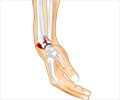
‘Majority patients were observed to be exposed to one non-opiate drug associated with increased fracture risk in four months before the fracture.’
Tweet it Now
In the study, published online by JAMA Internal Medicine, the researchers analyzed data from a sample of 168,133 Medicare beneficiaries (84% of whom were women with an average age of 80) who experienced a fracture of the hip, shoulder of wrist (the most common type of fragility fractures). The researcher team identified 21 drug classes that have been associated with increased fracture risk. After examining them as a single group, they then subdivided them into three groups: those drugs thought to increase fracture risk by increasing the risk of falls, those that decrease bone density, and those in which the mechanism which caused greater fracture risk was unclear. Medicare Part D retail pharmacy claims were used to measure fills for prescriptions associated with increased fracture risk both before and after the fracture occurred. Among their findings after analysis:- More than three-quarters of the patients in the study were exposed to at least one non-opiate drug associated with an increased fracture risk in the four months before their fracture.
- About 7% of patients discontinued these drugs after their fracture but that decrease was offset by new users so the total proportion exposed to high risk drugs did not change.
"The use of drugs that can contribute to elevated fracture risk was common among the group we studied," said lead author Jeffrey Munson, assistant professor at The Dartmouth Institute. "To add to that, we did not see a consistent reduction in the use of these drugs after the fracture event. So that allows for the strong possibility we may be able to prevent at least some of these secondary fragility fractures through better management of high-risk drugs around the time of the first fracture."
The study's authors noted that additional research was needed to determine the possible benefits of modifying post-fracture drug exposure in this high-risk population.
Source-Eurekalert















